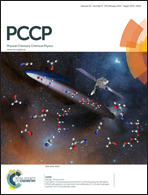Theoretical investigation of the effects of doping on the electronic structure and thermoelectric properties of ZnO nanowires
Abstract
The effects of doping ZnO nanowires with Al, Ga and Sb on their electronic structure and thermoelectric properties are investigated by first-principles calculations. We find that the band gap of ZnO nanowires is narrowed after doping with Al and Ga, while band gap broadening is observed in Sb doped ZnO nanowires. The lattice thermal conductivity of ZnO nanowires is obtained based on the Debye–Callaway model. The thermoelectric properties of ZnO nanowires were calculated using the BoltzTraP code. The results show that there exists an optimal carrier concentration yielding the maximum value of ZT for Al, Ga and Sb doped ZnO nanowires at room temperature. The maximum value of ZT, 0.147, is obtained for Ga doped ZnO nanowires, when the carrier concentration is 3.62 × 1019 cm−3. The figure of merit ZT of Sb doped ZnO nanowires is higher than that of Ga doped ZnO nanowires when the temperature is between 400 K and 1200 K. We also find that Al doped ZnO nanowires always have poor thermoelectric properties, which means that the Al dopant may not be the optimal choice for ZnO nanowires in thermoelectric applications.


 Please wait while we load your content...
Please wait while we load your content...